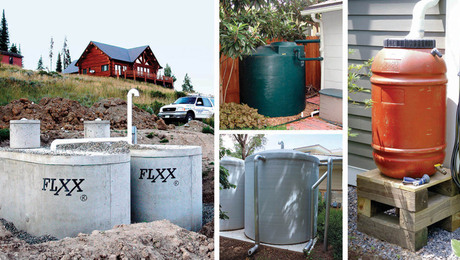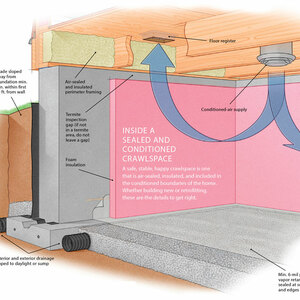Anybody got any ideas on how to make a leak free connection from 3 inch (ID) clay pipe to 3 inch PVC? Fernco doesn’t make a flexible connection and the 4 inch (closest to the OD) won’t tighten doen enough. Is there a trick or commercially available bushing out there?
Backgound: the 3 inch seems to be the weeping tile which is (mysteriously) under the basement concrete (house built in 1919). I found it the hard way while chasing down a leak that was quickly revealed to be a hornets nest of broken and just plain bad plumbing. I’ve replaced about 6 feet of pipe (sanitary) so far and I’m having a camera guy come trace the pipe before I do any more digging.
Another question: If I’ve successuflly taken care of the leak, should I expect a lttle bit of water (the earht is totally saturated) or should it stay completely dry? As I write this I realize what a dumb question this might be, but seriously, I don’t want to break any more concrete and dig any more. Wishful thinking?


















Replies
I've made a strong and leak-free connection like this using fiberglass cloth and resin. Easy to use, permanent, inexpensive, and very effective for that transition.
Fernco make a connector for every thing, get on the web site and look.
Maybe you supplier doesn't stock it?
Fernco does make transition fittings. Did you look into that?
I called Fernco, and the best they can do is a bushing that no one around Cleveland stocks. The sizes also vary by the manufacturer of the crock (the OD's are different) so I'm gambling even if I get one shipped. Thanks for the suggestion.
I agree that it shouldn't be. Imagine my surprise when I opened the floor to find a hole in the top of the crock (after the trap, no wnder it selled musty all the time) with a weeping tile over the top of it, with a corresponding hole in the bottom of it. It was no accident, either. There were several briks arranged to "funnel" the storm water from the weeping tipe into the sanitary. Not sure I have any choice but to re-connect it to the sanitary (with PVC and a trap) without the extreeme of difgging up the whole basement.
I've got a guy coming Sat. to send a camera down to see where it leads. I'm on hold till then.
What a minute... I didn't read it carefully enough.
If the weeping tile is headed for a municipal sanitary sewer, shouldn't all the clay tile be dug out and disposed of? In some ways this should simplify things... then you can just add in a new ABS line from your stack exit to the sanitary.
Of course, when the guy gets a peek at that he may call the sewer cops on you. Around here such a connection is just plain illegal and we'd get slapped with a fine if we had it.
Weeping Tile
>>>Backgound: the 3 inch seems to be the weeping tile which is (mysteriously) under the basement concrete (house built in 1919).<<<
Thats the whole reason it's in there, to drain the underground water below the slab. that tile should be porous so you can't replace too much with solid pvc.
>>>Another question: If I've successuflly taken care of the leak, should I expect a lttle bit of water (the earht is totally saturated) or should it stay completely dry?<<<
It shouldn't stay completely dry, there's ground water under the concrete, thats why you have the tile,
It looks like you have a strange hook-up, it used to be 3or 4 inch for drain tile and a MINIMUM of 6in for sanitary, are you sure you don't have something that was jerry rigged?
To get a coupling you have to measure from the same dimension, i.d. to i.d., or o.d. to o.d..
Thanks for the thoughtful response. No doubt it was jerry rigged. Just trying to figure out what Jerry was thinking when he did it.
Here's my theory: Owner calls Jerry because the basement has water in it. Jerry, hwo had a few pints the night before, digs up the concrete and says, "Here's the problem, your weeping tile is pitched to the center so the water can't get out. Luckily, your sanitary sewer line is right below! I'll just poke a hole in the top of it and poke a hole in the bottom of the weeping tile and use these old bricks to direct the flow and jus like that, no more water!" Then he filled the hole and covered it with new concrete and went on his way. He never stuck around for the sewer gas stink to develop from the hole he punched in the sewer.
I'm starting to think about putting in a sump pump to deal with the groundwater issue, once I can confirm by camera that I don't have any other cracks in the sanitary system. That way I can fill the hole with gravel, let gravity bring the water to the sump and pump it out to sanitary from there. Thoughts?
I think a sump pump might be a wise idea, if you don't have a storm sewer that you can drain into directly.
Be sure to NOT feed the sump pump into the sanitary -- either feed it to a storm sewer or outside somewhere.
Drain Tile?
Not knowing where you live I think that it would be a good idea to run the drain tile to a sump and not dump it into a sewer ( most areas will not allow ground water into the sanitary).
Using a camera is a good idea, the old clay pipe was notorious for being put in without following proper installation procedures the it ended up with cracks and dips in the line
Any sewer gas smell needs to be addressed, sewer gas is a potential health problem, luck.
Are you sure this wasn't an original basement floor drain? They were almost standard in 1919 houses.